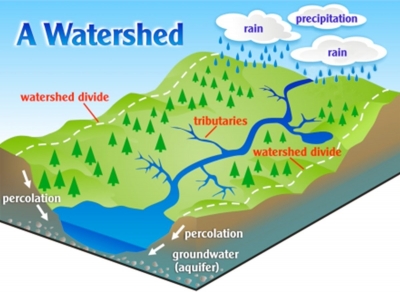
|
A river can originate from the end of a melting glacier or snow. It can also start from a lake or a spring. As it flows downstream, the river is joined by many tributaries, which increase its flow to make one large river. The land area that feeds, or drains into, a specific river and its tributaries is the watershed for that river system. |
A watershed is an area of land that drains or “sheds” water into a specific waterbody. Every body of water has a watershed. Watersheds drain rainfall and snowmelt into streams and rivers. These smaller bodies of water flow into larger ones, including lakes, bays, and oceans. Gravity helps to guide the path that water takes across the landscape.
Not all rain or snow that falls on a watershed flows out in this way. Some seeps into the ground. It goes into underground reservoirs called aquifers. Other precipitation ends up on hard surfaces such as roads and parking lots, from which it may enter storm drains that feed into streams.
Watersheds can vary in size. A watershed for a tiny mountain creek might be as small as a few square meters. Some watersheds are enormous and usually encompass many smaller ones. The Mississippi River watershed is the biggest watershed in the United States, draining more than three million square kilometers (one million square miles) of land. The Mississippi River watershed stretches from the Appalachian Mountains in the east to the Rocky Mountains in the west. Thirty-one U.S. states and two Canadian provinces fall within the Mississippi River watershed.
Credit: National Geographic Society
Picture Credit : Google




